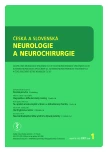Intravenous Thrombolytic Therapy with Recombinant Tissue Plasminogen Activator rt-PA (Actilyse®) – Our First Experience from Practice
Authors:
J. Pribula 1; P. Grajcar 2; A. Pribulová 3
Authors‘ workplace:
neurologické oddělení, Městská nemocnice, Litoměřice
1; kardiovaskulární JIP, Městská nemocnice, Litoměřice
2; rehabilitační oddělení, Městská nemocnice, Litoměřice
3
Published in:
Cesk Slov Neurol N 2007; 70/103(1): 57-61
Category:
Short Communication
Motto:
„ … nejvyšší prioritou je léčit všechny pacienty bezodkladně. To znamená, že týmy specializované na léčbu akutních ischemických iktů by měly zaměřit celé své úsilí na redukci času od příjezdu pacienta do nemocnice po zahájení léčby rt-PA za účelem zlepšit možnosti na příznivější uzdravení“ [1].
Profesor Werner Hacke, přednosta Neurologické kliniky, Univerzita v Heidelbergu, Německo, předseda vědecké komise studie ECASS II
Overview
The report has analysed the first experience with intravenous thrombolytic therapy using recombinant plasminogen activator (rt-PA) in patients suffering from acute ischemic cerebrovascular accident (aiCV A) at the therapeutical interval by 3 hours since the development of the ictus symptomatology. Its course, results and safety in local conditions have been assessed retrospectively. Within January 2005 – June 2006, 203 patients with aiCVA were treated in our centre. Systemic intravenous thrombolytic therapy with rt-PA was applied in 8 of them (3.94 %). The indication criteria were identical with the recommendations issued by the Česká lékařská komora (ČLK). Thrombolytic therapy was given to five men and three women with the average age of 57 years. Mean period between developing the first signs of aiCVA and i.v. application of rt-PA was 107 minutes, and that elapsed between the patient´s admission to an emergency department and initiating i.v. rt-PA was 65 minutes. Clinically insignificant small intracerebral haemorrhage was observed in two cases with input hypertension. aiCVA relapsed in one case after successful thrombolysis carried out in the interval of 50 hours. No fatal complication was seen in the periprocedural course. A microset of eight patients evaluated retrospectively showed early improvement of their general conditions assessed as a reduction of clinical neurological deficit minimally by 4 points according to the NIHSS scale in the course of the first 24 hours after thrombolysis. The effects of thrombolytic therapy are evident even in the picture of ADL (Activity of Daily Living) scoring 90 days after the ictus development.
Key-words:
recombinant tissue plasminogen activator, rt-PA, therapy for acute ischemic ictus
Sources
1. Hacke W, Kaste M, Fieschi C et al. Randomised double-blind placebo controlled trial of trombolytic therapy with intravenous alteplase in acute ischemic stroke (ECAS II). Second European-Australasian Acute Stroke Study Investigators. Lancet 1998; 352: 1245-51.
2. Česká lékařská komora. Závazné odborné stanovisko č.4/2004. Léčba akutní fáze mozkového infarktu. Tempus medicorum 2004; 12: 4.
3. Hacke W, Kaste M, Fieschi C et al. Intravenous trombolysis with recombinant tissue plasminogen activator for acute hemispheric stroke (ECASS I). JAMA 1995; 274: 1017-25.
4. Clark WM, Wissmann S, Albers GW et al. Recombinant tissue plasminogen activator (alteplase) for ischemic stroke 3-5 hours after symptom onset: the ATLANTIS Study: a randomised controlled trial: Alteplase Thrombolysis for Acute Noninterventional Therapy in Ischemic Stroke. JAMA 1999; 282: 2019-26.
5. Alberts GW, Clark WM, Madden KP et al. ATLANTIS trial: results for patient treated within 3 hours of stroke onset. Alteplase Thrombolysis for Acute Noniterventional Therapy in Ischemic Stroke. Stroke 2002; 33: 493-6.
6. Hacke W, Brott T, Caplan L et al. Thrombolysis in acute ischemic stroke. Controlled trials and clinical experience. Neurology 1999; 53(7, Suppl 4): S3-14.
7. Spitzer K, Smutzhard E. Documentation and Scores. In: Hacke W (ed). Neurocritical Care. Berlin: Springer-Verlag 1994: 47-56.
8. Mikulík R, Dufek M. Trombolytická léčba mozkového infarktu – prospektivní sledování souboru pacientů. Čes a Slov Neurol Neurochir 2002; 65/98: 328-33.
9. Sulter G, Steen Ch, De Keyser J. Use of the Barthel Index and Modifiesd Rankin Scale in Acute Stroke Trials. Stroke 1999; 30: 1538-41.
10. van Swieten JC, Koudstaal PJ, Visser MCet al. Interobserver agreement for the Assesment of handicap in stroke patients. Stroke 1988; 19: 604-7.
11. Collin C, Wade DT, Davies S et al. The Barthel ADL index: a reliability study. Int Disability Study 1988; 10: 61-3.
12. Albert MJ, Hademenos G, Latchaw RF et al for the Brain Atack Coalition. Recommendations for the Establishment of Primary Stroke Centers. JAMA 2000; 283: 3102-9.
13. Pracovní skupina Cerebrovaskulární sekce České neurologické společnosti ČLS JEP. Standard pro podání systémové trombolýzy pacientům s akutním mozkovým infarktem. Čes a Slov Neurol Neurochir 2006; 69/102: 151-6.
14. Kalina M. Akutní neurologie. Praha: Triton 2000.
15. Cort MA, Kuo D. Ischemic Stroke Syndromes: The Challenges of Assessment, Prevention and Treatment. Part II: Physical Examination, Laboratory Investigation, Imaging, and Treatment. Emerg Med Rep 2004; 25/6: 69-79.
16. Derex L, Hermier M, Adeleine P, Pialat JB, Wiart M, Berthezène Y et al. Clinical and imaging predictors of intracerebral haemorrhage in stroke patients treated with intravenous tissue plasminogen activator. J Neurol Neurosurg Psychiat 2005; 76: 70-75.
17. Wiegand N, Lűthy R, Vogel B, Straumann E, Beynon Ch, Bertel O et al. Intravenous thrombolysis for ischaemic stroke is also safe and efficient without a specialised neuro-intensive care unit. Swiss Med Wkly 2004; 134: 14-17.
Labels
Paediatric neurology Neurosurgery NeurologyArticle was published in
Czech and Slovak Neurology and Neurosurgery

2007 Issue 1
Most read in this issue
- Panic Disorder – Neuropsychiatric Profile
- The Liquor Tau Protein and Beta Amyloid in Alzheimer’s Disease
- Diagnosis and treatment of leptomeningeal carcinomatosis in solid tumors
- Surgical treatment of the metastatic cervical spine tumours
